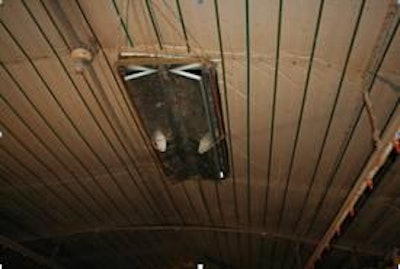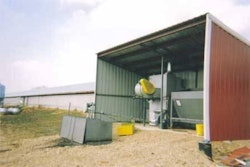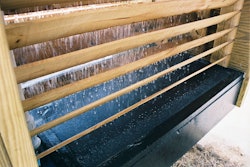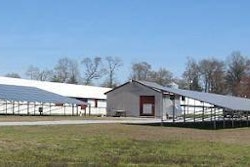
Energy costs are much higher this year than in the past. In an effort to reduce the burden of increased fuel cost on the farmer, a system was designed to ventilate using air from the attic instead of the outside air. The vent doors that are typically used in the sidewalls are still present, but there is an additional set of vent doors along the centerline of the house ceiling. The ceiling vent doors are centered between the sidewall vent doors to minimize disruption of airflow when both systems are used simultaneously. The vent doors are attached to the bottom of a plenum and pointed in opposite directions. This plenum is deep enough to protrude above the insulation, which will allow the air into the plenum without disturbing the insulation.
David Hudson, a grower for Wayne Farms in Laurel, Miss., installed the system when retrofitting his farm.
A conventional vent machine is connected to the ceiling vent doors; the ceiling vent machine moves the ceiling vent doors twice as fast as the outside vent machine moves its vent doors. Air comes in through the attic vent doors first. The center vent doors are set to open a maximum of two to three inches. If additional air is needed because of higher static pressure, the controller calls for more air, which then opens the side vent doors to satisfy the controller. In cases when the attic temperature is too warm for the attic vent system to operate, the grower can simply disengage the system.
The ceiling vent doors are installed back to back. This creates an air pattern from the middle of the house toward the sidewalls versus traditional pattern from the sidewalls to the middle of the house. Infrared photography shows this ventilation pattern in Hudson’s broiler house, and it is evident where each set of vent doors is located down the house. By the time the air out of the attic has reached the sidewall, the mixing of the attic air with the house air combines for a comfortable temperature for the chick. The mixing of the air is evident by looking at the infrared pictures.
Temperatures in the attic can range from 10 to 15 degrees warmer than outside air on a sunny day in cold weather. The temperature differential from outside to attic temperature may be 30 to 40 degrees during the summer. Generally, one would not use the system during the hot summer months with birds in the house because of the high temperatures it can create within a house. However, air temperatures in the house may be increased to as much as 130 F using the system, and this elevated temperature can help dry the house, kill microorganisms and purge ammonia when the house is empty.
One favorite question is, “How much heat is in the attic?” That can depend on many factors, but consider the following example. On a typical sunny day in winter when the outside temperature is 50 F, and assuming a 15 degree increase in attic temperature and one 20,000 CFM fan operating one minute out of five minutes, this would contribute approximately 45,000 BTUs of heat to the house per hour, conservatively, for six hours. This heat is equivalent to approximately one-half gallon of LP gas per hour. Using gas prices of $1.50 per gallon, the attic ventilation system can save three gallons of LP per day ($4.50) with a 15-degree rise in temperature and 60-second runtime of the fan.
The more fans being run, and/or the longer they are operated, the more money that can be saved. For example, one fan running for three minutes would save $13.50 per day in gas. When using the attic ventilation system, the attic temperature shows only a small decrease, at worst a couple of degrees. An enormous amount of heat is available because approximately 1,000,000 BTUs per hour strike the south half of the roof of a 44-foot x 500-foot house. Realistically, we may only get 5 percent to 10 percent of this heat, but even a good solar cell is only about 15 percent efficient.
The attic ventilation system shows promise as a simple method to help poultry farmers reduce their dependence on fossil fuel. New house construction can incorporate the system for $1,500 to $2,000 per house.

















